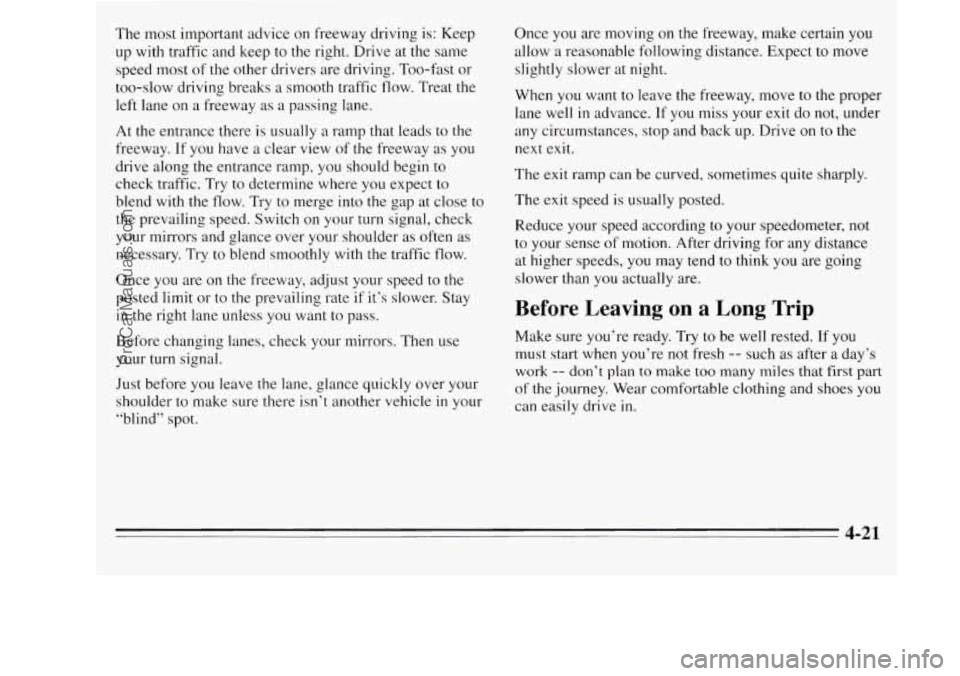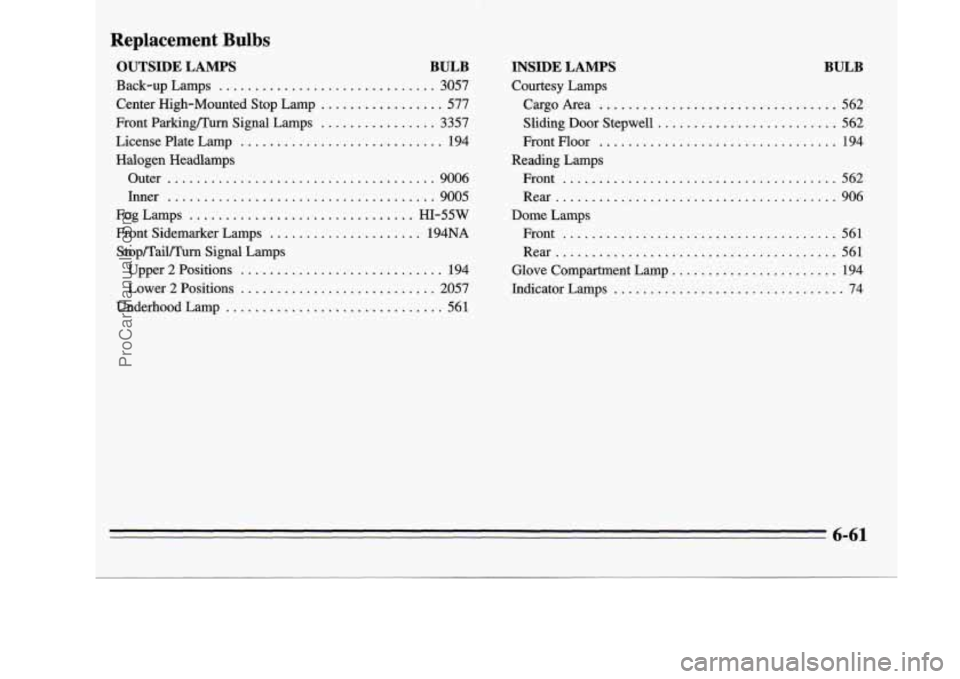Page 201 of 390
poles, or other vehicles, and raindrops “dimple” the
water’s surface, there could be hydroplaning.
Hydroplaning usually happens at higher speeds. There
just isn’t a hard and fast rule about hydroplaning. The
best advice is
to slow down when it is raining.
Some Other Rainy Weather Tips
Turn on your low-beam headlamps -- not just your
parking lamps
-- to help make you more visible to
others.
Besides slowing down, allow some extra following
distance. And be especially careful when you pass
another vehicle. Allow yourself more clear room
ahead, and be prepared to have your view restricted
by road spray.
Have good tires with proper tread depth. (See
“Tires” in the Index.)
City Driving
One of the biggest problems with city streets is the
amount of traffic on them. You’ll want to watch out for
what the other drivers are doing and pay attention
to
traffic signals.
4-19
ProCarManuals.com
Page 202 of 390
Here are ways to increase your safety in city driving:
Know the best way to get to where you are going.
Get
a city map and plan your trip into an unknown
part
of the city just as you would for a cross-country
trip.
Freeway Driving
Try to use the freeways that rim and crisscross most
large cities. You’ll save time and energy. (See the
next part, “Freeway Driving.”)
Treat a green light as a warning signal. A traffic light
is there because the corner is busy enough
to need it.
When a light turns green, and just before you start
to move, check both ways for vehicles that have
not cleared the intersection or may be running the
red light.
Mile for
mile, freeways (also called thruways, parkways,
expressways, turnpikes. or superhighways) are the safest
of all roads. But they have their own special rules.
4-20
ProCarManuals.com
Page 203 of 390

The most important advice on freeway driving is: Keep
up with traffic and keep to the right. Drive at the same
speed most
of the other drivers are driving. Too-fast or
too-slow driving breaks
a smooth traffic flow. Treat the
left lane on
a freeway as a passing lane.
At
the entrance there is usually a ramp that leads to the
freeway.
If you have a clear view of the freeway as you
drive along the entrance ramp, you should begin
to
check traffic. Try to determine where you expect to
blend with the flow. Try to merge into the gap at close to
the prevailing speed. Switch on your turn signal, check
your mirrors and glance over your shoulder
as often as
necessary. Try to blend smoothly with the traffic flow.
Once
you are on the freeway, adjust your speed to the
posted limit or to the prevailing rate if it’s slower. Stay
in the right lane unless you want to pass.
Before changing lanes, check your mirrors. Then use
your turn signal.
Just before you leave
the lane, glance quickly over your
shoulder to make sure there isn’t another vehicle
in your
“blind” spot. Once
you are moving on the freeway, make certain you
allow
a reasonable following distance. Expect to move
slightly slower at night.
When you want to leave the freeway, move to the proper
lane
well in advance. If you miss your exit do not, under
any circumstances, stop and back up. Drive on to the
next exit.
The
exit ramp can be curved, sometimes quite sharply.
The exit speed is usually posted.
Reduce your speed according to your speedometer, not
to your sense
of motion. After driving for any distance
at higher speeds, you may tend to think you are going
slower than you actually are.
Before Leaving on a Long Trip
Make sure you’re ready. Try to be well rested. If you
must start when you’re not fresh
-- such as after a day’s
work
-- don’t plan to make too many miles that first part
of the journey. Wear comfortable clothing and shoes you
can easily drive
in.
4-21
ProCarManuals.com
Page 219 of 390

Making Turns
1 NOTICE:
Making very sharp turns while trailering could cause the trailer to come in contact with the vehicle. Your vehicle could be damaged. Avoid
making very sharp turns while trailering.
When you’re turning with a trailer, make wider turns
than normal.
Do this so your trailer won’t strike soft
shoulders, curbs, road signs, trees,
or other objects.
Avoid jerky or sudden maneuvers. Signal well
in
advance.
Turn Signals When Towing a Trailer
When you tow a trailer, your vehicle has to have extra
wiring and a different turn signal flasher (included in the
optional trailering package). The green arrows on your
instrument panel will flash whenever you signal a
turn
or lane change. Properly hooked up, the trailer lamps
will also flash, telling other drivers you’re about to turn,
change lanes or stop. When
towing a trailer, the green arrows on your
instrument panel will flash for turns even
if the bulbs on
the trailer are burned out. Thus, you may think drivers
behind you are seeing your signal when they are not.
It’s
important to check occasionally to be sure the trailer
bulbs are still working.
Driving On Grades
Reduce speed and shift to a lower gear before you start
down
a long or steep downgrade. If you don’t shift
down, you might have
to use your brakes so much that
they would get hot and no longer work well.
On a long uphill grade, shift down and reduce your
speed to around
45 mph (70 km/h) to reduce the
possibility of engine and transaxie overheating.
If you are towing a trailer that weighs more than
1,000 pounds (454 kg), and you have an automatic
transaxle with OVERDRIVE
(GO), you may prefer to
drive
in THIRD (D) instead of OVERDRIVE (0)
(or, as you need to, a lower gear). This will minimize
heat build-up and extend the life of your transaxle.
-
4-37
ProCarManuals.com
Page 223 of 390
w
Section 5 Problems on the Road
Here you’ll find what to do about some problems that
can occur
on the road.
Hazard Warning Flashers
Your hazard warning flashers let you warn others.
They
also let police know you have a problem. Your
front and rear turn signal lamps will flash on
and off.
Your hazard warning flashers switch
is on the steering
column, below the ignition switch.
Press the button in to
turn
on your flashers.
5-1
ProCarManuals.com
Page 224 of 390
Your hazard warning flashers work no matter what
position your key is in, and even if the key isn’t in.
To turn off the flashers, pull out on the collar.
When the hazard warning flashers are on, your turn
signals won’t work.
Other Warning Devices
If you carry reflective triangles, you can set one up at the
side of
the road about 300 feet (100 m) behind your vehicle.
Jump Starting
If your battery has run down, you may want to use
another vehicle and some jumper cables to start your
Oldsmobile. But please follow the steps below to do it
safely.
On vehicles equipped with the optional power sliding
door, a low voltage battery or replacing a battery may
cause the system to become inoperative. Refer to “Power
Sliding Door” in the Index for more information.
5-2
ProCarManuals.com
Page 293 of 390
4.
5.
6.
Pull off the entire taillamp housing.
Pinch the lever and twist the bulb assembly
116 turn
counterclockwise to remove.
Remove the bulb by pressing in and turning 1/8 turn
counterclockwise.
Line up the small retainer bumps on the replacement
bulb
so that the lower bump slides into the deepest
slot in the housing. Press in and twist the bulb 1/8 turn clockwise. Reposition
the bulb assembly in
the taillamp housing.
Turn the assembly 116 turn
clockwise to lock in place.
8. Replace the entire taillamp housing and screws.
9. Attach the spring clips to the taillamp housing and
secure them.
10. Close the rear side windows and liftgate.
11. Test the bulbs by using your turn signals and
taillamps.
6-33
ProCarManuals.com
Page 321 of 390

Replacement Bulbs
OUTSIDE LAMPS BULB
Back-upLamps .............................. 3057
Center High-Mounted Stop Lamp
................. 577
Front Parkinown Signal Lamps
................ 3357
License Plate Lamp
............................ 194
Halogen Headlamps Outer
..................................... 9006
Inner
..................................... 9005
FogLamps
............................... HI-55W
Front Sidemarker Lamps ..................... 194NA
Stop/Tail/Turn Signal Lamps
Upper 2 Positions
............................ 194
Lower 2 Positions
........................... 2057
Underhood Lamp
.............................. 561
INSIDE LAMPS BULB
Courtesy Lamps Cargo Area
................................. 562
Sliding Door Stepwell
......................... 562
FrontFloor
................................. 194
Reading Lamps Front
...................................... 562
Rear
....................................... 906
Dome Lamps Front
...................................... 561
Rear
....................................... 561
Glove Compartment Lamp
....................... 194
Indicator Lamps
................................ 74
6-61
ProCarManuals.com